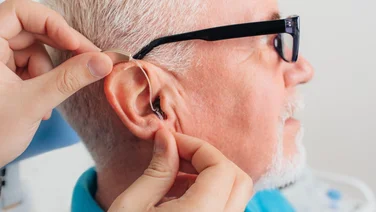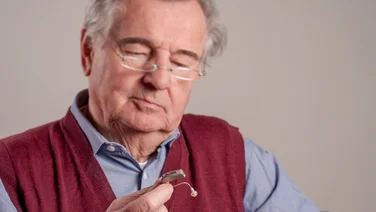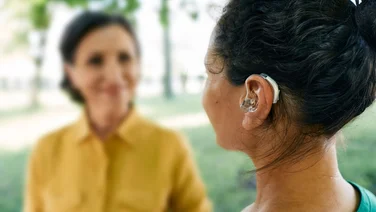Many people with hearing loss – both children and adults – can regain a good amount of their hearing by wearing a hearing aid.
However, hearing aids may not always be a suitable option for everyone. If you have permanent, very severe hearing loss, you might find wearing a hearing aid doesn’t amplify sound enough for you to get any benefit from it.
If this is you, then you may be a candidate for a cochlear implant. This is a small, electronic device designed to improve hearing for those with severe or profound hearing loss.
Unlike hearing aids, cochlear implants have a component that’s placed inside your ear during an operation. Although there are many potential advantages to having a cochlear implant, there are also risks you need to consider.Remember, if your hearing is starting to bother you, or is gradually getting worse, it’s always worth speaking to a professional. We can connect you with a local audiologist to get you the help you need. Fill in our quick form and we’ll do the rest.
What is a cochlear implant?
A cochlear implant is an electronic device that can help people who are hard of hearing or profoundly deaf to hear sound.
Cochlear implants don’t amplify sounds like hearing aids do; instead, the components that are implanted inside the head and ear take sound signals straight to the cochlea in the inner ear, directly stimulating the auditory nerve.
In doing so, they enable sound to bypass parts of the ear that are damaged or don’t work properly.
A cochlear implant doesn’t restore hearing, but enables profoundly deaf people to experience the sensation of sound. In turn, this can help improve communication and lead to a better quality of life.
While many hearing aids need to be custom-made and then adjusted to your individual needs, a cochlear implant requires surgery.
How do cochlear implants work?
To understand how a cochlear implant works, it helps to know a little bit about how the auditory system works.
The auditory system
The auditory system is responsible for your sense of hearing and how you understand sounds. It includes the ears, the nerve connecting the inner ear to the brain, and parts of the brain that process sound.

The ear is made up of three sections: the outer ear, middle ear, and inner ear.
Sound waves enter the outer ear through the ear canal, traveling to the eardrum in the middle ear. This causes the eardrum and the tiny bones in the middle ear – the ossicles – to vibrate.
The vibrations pass to the inner ear and the cochlea, which is a hollow, snail-shaped structure that’s filled with fluid and lined with thousands of tiny hair cells.
The hair cells convert the vibrations into electrical impulses, which travel through the auditory nerve to the brain. The brain then interprets these electrical impulses as sounds.
When we experience any degree of hearing loss, it’s because something has gone wrong somewhere in the auditory system.
The role of a cochlear implant
If you’re a candidate for a cochlear implant, it’s likely you have what’s known as sensorineural hearing loss. It’s the most common type of permanent hearing loss.
With this type of hearing loss, there’s damage to a part of the inner ear – usually to the tiny hair cells in the cochlea, meaning they are unable to convert soundwaves into electrical impulses.
You might have some damage to the auditory nerve, but it’s usually partially or completely intact and functional.
A cochlear implant does the job of the damaged hair cells and stimulates the auditory nerve.
The components of a cochlear implant
There are two main components that make up a cochlear implant device: the internal part that’s surgically implanted underneath the skin, and the external part that sits over the ear and connects to the internal component via magnets.
The external (behind the ear) component comprises:
- A microphone that detects sound from the environment
- A speech processor that ‘organizes’ the sounds picked up by the microphone
- A transmitter that receives signals from the speech processor and connects them with the internal part of the implant. This contains a small magnet
The internal (surgically implanted) component comprises:
- A receiver/stimulator (also containing a small magnet) that takes the signals from the transmitter and converts them into electrical impulses
- A thin wire connecting the stimulator to the cochlea, as well as a series of electrodes at the end called an electrode array
- Electrodes (part of the electrode array) that take different sound pitches and stimulate different parts of the cochlea and activate the auditory nerve
In some cochlear implant devices, the microphone and speech processor are housed in a casing that hooks over the top of the ear – much like a behind the ear hearing aid.
A short wire connects the casing to the transmitter. This is a small, lightweight disc with a magnet in the middle. This is placed on the outside of the head, over the space where the receiver sits under the skin.
Other devices have all the external components in one unit which is placed on the outside of the head, over where the internal receiver sits under the skin. This type is slightly bigger and bulkier than the transmitter described above.
Because the transmitter and the receiver both include a magnet, the all-in-one external unit or the separate transmitter disc stay in place.

Cochlear implant surgery
Cochlear implant surgery is quite complex because the internal components are small and placing theme without damaging any other tissue is a delicate process.
A small amount of your hair will need to be shaved off where the incision is made. If you have long hair, you can have it cover the site post-op.
The operation normally takes a few hours and you’ll probably stay in hospital overnight. Over the following weeks, the surgical site needs to heal before the external part of the device can be connected and tuned.
After the surgery
When the surgery site has healed, the external part of the cochlear implant device needs to be fitted. This is usually done by your audiologist and doesn’t require a stay in hospital.
The audiologist will make sure all of the components work together, adjust the speech processor to fit, and determine the sounds you can hear. It can take a while to tune the implant to suit your particular needs.
When the cochlear implant is ‘switched on,’ you will experience the first sounds through the device. If you’ve been profoundly deaf since birth, this will be the first time you ‘hear.’ It can be an emotional and overwhelming experience.
Cochlear implant surgery risks
Just like with any other kind of surgery, a cochlear implant operation does carry some risks.
- Complications from general anesthetic
- Injury to the facial nerves
- Infection around the incision site
- Meningitis – people with inner ear structural abnormalities may be more at risk
- Dizziness or vertigo episodes
- Tinnitus (ringing in the ears)
- A change in sense of taste
- Numbness around the implant or ear
There might be other risks or possible complications, but your audiologist can talk you through these early on when deciding whether or not a cochlear implant is right for you.
Getting used to a cochlear implant
After your cochlear implant has been activated, you’ll need to undergo a period of what’s known as auditory training, or auditory rehabilitation. It will usually involve audiology and speech and language therapy services, with regular visits to fine-tune the acoustics.
Auditory training also helps your brain to learn to process new sounds, and to interpret and make sense of what you hear.
This can be a long, demanding process that you will need to manage for life, and you might find it difficult to start with.
If you previously had hearing but developed hearing loss, you’ll experience speech and other sounds very differently with a cochlear implant. If you’ve always had severe or profound hearing loss, everything will be completely new.
But, when the components work to your needs and you’ve become accustomed to living with a cochlear implant, it can make your everyday life easier.
Can babies and children have cochlear implants?
Cochlear implants are suitable for babies and children if they are profoundly deaf or have severe hearing loss that isn’t improved with hearing aids.
Evidence suggests that the younger a child is when they receive a cochlear implant, the more benefit they will get from it.

In the UK, it’s common for infants to have a cochlear implant before their first birthday.
How much do cochlear implants cost?
In the UK, the costs of cochlear implants, surgery, auditory training, and repairs or adjustments are covered by the NHS.
In the US, cochlear implants are often covered by private healthcare insurance, or via Medicaid or Medicare, although you will probably still need to pay for some expenses and ongoing maintenance.
It’s a good idea to contact your audiologist or healthcare provider for more information about covering the costs of your cochlear implants.
Should I have a cochlear implant?
A cochlear implant cannot restore normal hearing, nor will it replicate speech and other sounds around you. It is also worth noting that not everyone who chooses to have a cochlear implant adjusts to it.
But for most people, having a cochlear implant has many benefits.
Benefits of cochlear implants
An implant can give you a decent hearing experience, with some people reporting they achieved an almost normal ability to understand speech.
For some people, a cochlear implant is not that successful, but it enables them to perceive everyday sounds like traffic, a phone ringing, an alarm going off, and a dog barking. This can be a real plus point in terms of safety.

In addition to communicating better with people in the same room as you or over on the phone, you may also be able to watch TV and even listen to and hear music.
You can also safely take part in sports and other activities in the same way hearing people do – it’s recommended that you remove or ‘take off’ the external component of the device for things like contact sports and swimming.
However, aside from the risks of surgery, there are other potential drawbacks associated with cochlear implants.
Drawbacks of cochlear implants
Many people describe the sound they perceive as artificial, and report that speech sounds ‘robotic,’ which can be hard to adjust to. However, most people do get used to it in time.
For people who still had a small degree of hearing before their implant, it can sometimes diminish the ‘natural’ residual hearing on the implanted side. And, if the internal component of the device becomes damaged in any way, it might mean more surgery to replace it.
If you have to pay for your cochlear implant or its maintenance, it can be very expensive.
Your life might be affected in other ways you haven’t thought about, too. For example, cochlear implants sometimes interfere with electrical signals on other devices, or set off metal detectors, theft detection systems, or airport security alarms.
They can become damaged by static electricity, and you may be unable to undergo certain medical investigations, like MRI scans and some types of therapy involving electrical signals.
Are cochlear implants controversial?
Cochlear implants are not a silver bullet to ‘cure’ deafness, and many people in the deaf community and healthcare professionals who work with them have raised concerns.
It has been reported that, far from the positive emotional experience many people associate with cochlear implants being activated – a baby hearing its caregiver’s voice for the first time, for instance – it can sometimes be a traumatic event.
Cochlear implant recipients can feel frightened by the unexpected and sudden overwhelming sensory input. For some people, it takes months or years to ‘rewire’ the brain to make sense of any auditory input.
The concept of cochlear implants has implications for the deaf community, too. Some people think of cochlear implants as ableist, and a threat to deaf culture and identity.
Others argue that people with cochlear implants straddle the deaf world and the hearing world, but cannot properly integrate with either.
We can help you speak with a trained audiologist…
And find out if hearing aids are an option for you
Cochlear implants: next steps
If you are a candidate for a cochlear implant, it’s important that you gather as much information as you can and think about everything that’s involved. It’s a very personal and individual choice.
It might be helpful to discuss your options with friends and family members. Consult with your audiologist, too – they can help you to weigh up the pros and cons to reach a decision that is best for you.








